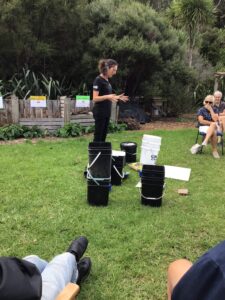Q&A with Kaipātiki Community Composting Hub
The second hub in our series is the Kaipātiki Community Composting Hub on Auckland’s North Shore. We chat with Joanne who gives us great insight into their hub, and some fantastic tips and advice for other community composters.
Tell us a bit about your organisation
We run two hubs, Kaipātiki (established 2021-22) and Hobsonville Community Compost Hub (established 2020). Our Teaching Garden team manages the hub, with help from volunteers who we are training to help support operations. We require all members to complete a Bokashi Composting Workshop, and then they are welcome to become a member, by arranging a visit to the hub or registering online here.

What did you use your Hub Fund grant money to purchase?
Weighing scales, and other tools to help operate the hub and measure volume of waste in and compost produced.
What advice would you give to someone/an organisation at the start of their composting hub journey?
We have learnt a lot along the way through trial and error, and visiting other hubs and talking about challenges and what works well. Our main tips would be to have someone manage the hub, who is also responsible for making sure the composting is done correctly, have a membership system so you can communicate to everyone using the hub, record data (the weight and volume of what is going in) to measure diversion from landfill, have an Abundant supply of carbon on hand (collaboration with a local arborist for mulch works well) so you can always cope with food inputs.
Other things to consider before you start are the flow – set up a space to receive and store inputs rather than people directly putting them in the bins, and what the main inputs will be – garden waste or food scraps, and set up the hub accordingly, and have good signage so people know where to put things.
Lastly, urban composting needs to be tidy and non-smelly so as to avoid attracting rats / scavengers and resulting complaints from neighbours. It is much easier to foresee these issues and set the hub up in a way you avoid any complaints in the first place. Vermin proof composters and ways to handle food scraps to contain odours, and flies are main things.
How do you promote and grow your hub?
We use various methods, including; dropping flyers about community composting in our local area, letterboxes, cafes, library, and community centres, sending a regular newsletter to members, and information on our website. We also hold open days where the community is invited to come and visit the hub, to see how it works, ask any questions, etc, and we host free bokashi workshops to educate about food scraps and how members use the hub.
Being listed on ShareWaste (the app and website connecting composting donors and hosts) has worked well too.
What would success look like in a year’s time for your community composting hub?
We would love to have four carbon boxes in a year’s time – two more than what we have now to enable a better operating system. This would mean we could increase membership to capacity (currently averaging one new household a week) and would not need to spend so much time and effort moving compost into storage bays.
What would be full capacity for your hub?
We are working on capacity of around 100-120 households (once we have 4 boxes) and estimating at full capacity we might expect to be processing 8-10 tonnes a year of which 30-40% would be food waste. We need another year to really get good data though so this is an estimate.
What was the most useful advice/help you received from your allocated Compost Collective facilitator?
We regularly work with the facilitators who have delivered workshops at our hubs, it’s a reciprocal relationship that achieves much success!
What would you say to someone starting on their composting journey?
Diverting your food scraps to your local community compost hub is perhaps one of the most empowering things each and every one of us can do to address the climate crisis. Food sent to landfill creates methane, a powerful greenhouse gas, and the nutrients these scraps could offer the soil are lost forever. Everyone eats food, and therefore everyone can be part of the solution. Using food scraps to make quality living compost, returns carbon and nutrients to the soil, generating fertility to grow more food.
Find our more about Kaipātiki’s community composting hubs here, and sign up to be a member here.